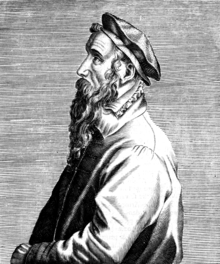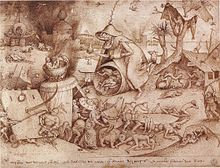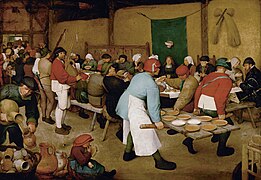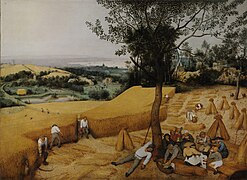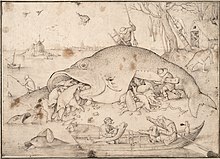Pieter Bruegel the Elder

Pieter Bruegel the Elder ([ brɔɪ̯ɡl̩ ] Dutch [ bɾøːɣəl ]; to * 1525 / 1530 probably in Breda ; † 9. September 1569 in Brussels ), called de Drol "the droll" or "Bauernbruegel", was a painter of the Dutch Renaissance . He is widely known for his depictions of rural life in the Duchy of Brabant ( Netherlands and Flanders ) in the 16th century.
About the spelling of the name

There are various spellings for the name. In addition to Brueghel , Breugel and Breughel , engravings based on his works also contain spellings such as Brügel , Brügl , Brögel and even Briegel , which record the actual or supposed pronunciation in German spelling.
The artist himself initially signed his works with Brueghel , but then changed this spelling to Bruegel in 1559 ; however, the reason for this is unknown. His two sons also used different spellings in the course of their lives.
In art history, the two forms of name coexisted in harmony, with most authors opting for the spelling without an "h". From the 20th century, the spelling with "h" was used less and less and is rarely found today. Most museums use the Bruegel spelling in their publications , which is now also indicated by the RKD - Nederlands Instituut voor Kunstgeschiedenis as the preferred spelling.
Life

Little is known with certainty about Pieter Bruegel's life:
According to Carel van Manders Het Schilderboeck ("Book of Painters"), which was published in Amsterdam in 1604, Bruegel was a student of the Antwerp artist Pieter Coecke van Aelst . Bruegel became a master there in 1551 and initially worked in the important copper workshop of Hieronymus Cock in Antwerp . During a trip to Italy between 1552 and 1555, on which landscape depiction was already a focus of his work, he lived in Rome for some time from 1553, where he worked for the miniature painter Giulio Clovio . Then he returned to Antwerp in Cock's copper workshop.
In 1563 he married Mayken Coecke (sometimes she is also called Maria Coecke van Aelst), the daughter of his former teacher, in the chapel church in Brussels . Not far from the church, he finally settled at Hoogstraat 132. The first son Pieter the Younger was born in 1564, the second son Jan 1568. Bruegel died on September 9, 1569 and, like his wife Maria, was buried in the chapel church in Brussels.
Bruegel's supporters included Cardinal Antoine Perrenot de Granvelle (Minister of King Philip II of Spain and advisor to Margaret of Parma , governor of the Netherlands ), Niclaes Jonghelinck (rich Antwerp collector and brother of the sculptor Jacques Jonghelinck ) and Abraham Ortelius (Antwerp geographer , Cartographer and bookseller).
Career and the work of his sons

With Bruegel, Flemish painting reached its climax; the masterful execution and profundity of his works was neither achieved before nor after his lifetime. Bruegel's idiosyncratic style cannot be adequately described with a single stylistic term such as mannerism . One of his great role models was Hieronymus Bosch , whose imagery he often quoted in his early works (for example in Die Dulle Griet or the Angel Fall ).
Together with his sons, Pieter Brueghel the Younger (called "Höllenbrueghel") and Jan Brueghel the Elder ("Blumenbrueghel"), he founded the Brueghel artist dynasty . Pieter Brueghel the Younger took over his father's workshop material and produced copies of his father's compositions almost in series. Jan Brueghel the Elder only copied a few of his father's pictures, but already in his own miniature style, and then developed very independently into the most important cabinet painter in Antwerp in the early 17th century. Jan's son Jan Brueghel the Younger and five of his seven sons also painted. However, none of the offspring was as successful as Pieter Bruegel the Elder.
Special exhibitions
- 2017: Bruegel. Drawing the world . Albertina , Vienna. Catalog.
- 2018/2019: Bruegel. Once in a Lifetime . Vienna Art History Museum
2019 marks the 450th anniversary of his death. A number of exhibitions and events are held in the cultural region of Flanders.
Works

Genres and motifs
Bruegel led the Flemish landscape painting to its peak in the 16th century, established the Dutch peasant genre and created numerous allegorical works relating to proverbs, folk culture and humanistic culture.
One of his most famous works is the picture entitled The Dutch Proverbs (now in the Gemäldegalerie in Berlin ), on which over a hundred Dutch proverbs are staged, some grotesque . Pictures like this one, with 100 or more people depicted (also called hidden objects ), can often be found in his oeuvre ; With skillful composition, such motifs also appear balanced.
Bruegel became particularly well known very early on (for example in Carel van Mander's judgment) for his depictions of peasant life, as found in peasant weddings or peasant dances . However, Bruegel's oeuvre can by no means be reduced to this; in fact, only a very small part of his oeuvre consists of such genre painting .
Bruegel's imagery is extremely complex, every little detail of his works is intentional and usually carries meaning. Symbols of death and perdition, of sin, for example in the sequence The Deadly Sins , but also of joie de vivre and virtues - cf. the sequence of stitches The Virtues , The Children's Games - run through his entire oeuvre and want to be discovered and considered. The upside-down world motif is of central importance here. It ultimately means a world without trust in God and is therefore sinful. It is the key to understanding many of his works. Scenes depicting innocent children's games or generally binding proverbs , however, do not allow a pessimistic view of the world, but rather conciliatory in the hope of a future certainty of salvation.
painting
Around forty paintings by Bruegel have survived, which are indisputably attributed to the artist.
Examples
The children's games around 1560
The triumph of death , 1562
Christ Carrying the Cross , 1564
The land of milk and honey , 1567
The peasant wedding , around 1568
The seasons pictures
The gloomy day , the hay harvest , the grain harvest , the return of the herd and the hunters in the snow belong to a series that was probably created in 1565 on behalf of the merchant, banker and art collector Nicolaes Jonghelinck , who also owned other pictures by Bruegel, e.g. B. The Children's Games and the Tower of Babel . In a guarantee by Jonghelinck from 1566, there is talk of “tweelf maenden” (twelve months), but today it is generally assumed that there were not twelve individual pictures, but only six pictures, each summarizing two months.
In 1594 Archduke Ernst received the pictures as a gift on the occasion of his entry into Antwerp, and on July 17, 1595, “Six Taffel, of 12 months of the Jars von Bruegel” were mentioned in his estate. The pictures did not reappear until 1659, as part of the Archduke Leopold Wilhelm's collection in the Vienna Stallburg . Now there was only talk of “five large pieces”. Since the five pictures have the same date, the same format and the same horizon line, they were first included in the same cycle in the 1920s.
In 1783 in the Vienna Belvedere , however, The Children's Games are listed as Spring and The Bethlehemitic Child Murder (probably a copy of Pieter Brueghel the Younger ) as Winter, while The Hunters in the Snow and The Dark Day were not mentioned again until 1884. The grain harvest reached France as early as 1809 and was finally bought by the Metropolitan Museum in New York in 1919 . The image of the haymaking reappeared in Bohemia under unexplained circumstances .
The gloomy day (early spring), 1565
The Hay Harvest
(Summer), 1565The grain harvest (midsummer), 1565
The Return of the Herd (Autumn), 1565
The Hunters in the Snow (Winter), 1565
Drawings (selection)
- Rest on the Flight into Egypt (1553/54, National Museums in Berlin )
- Forest Landscape with Playing Bears (1554, Národni Gallery , Prague)
- The big fish eat the small ones (1556, Albertina, Vienna)
- Painter and buyer (around 1565, Albertina, Vienna )
literature
- Nils Büttner: Pieter Bruegel the Elder Ä. , Verlag CH Beck Munich 2018, ISBN 978-3-406-72529-6 .
- Max Seidel and Roger H. Marijektiven: Bruegel , Belser Verlag Stuttgart, 1969.
- Ernst Günther Grimme : Pieter Bruegel the Elderly: Life u. Werk , Cologne, DuMont / Schauberg, 1973, ISBN 3-7701-0723-3
- Philippe et al. Francoise Roberts-Jones: Pieter Bruegel the Elder , Munich 1997, ISBN 3-7774-7540-8 .
- Roger H. Marijhnen: Bruegel. The complete work , Cologne 2003, ISBN 3-89340-046-X .
- Rainald Grosshans: Pieter Bruegel the Elder Ä .: The Dutch proverbs . Berlin: Gemäldegalerie 2003, ISBN 3-88609-484-7 .
- Martin Missfeldt: Pieter Bruegel the Elder Ä .: The Dutch proverbs . CD-ROM, DUPLICON, 1998, ISBN 3-936697-02-7 .
- Reinhard Liess : The small landscapes of Peter Bruegel the Elder. Ä. in the light of his oeuvre . In: Kunsthistorisches Jahrbuch Graz (ISSN 1010-3856) Vol. 15/16 (1979/80) pp. 1–116 u. Fig. 1-61, Vol. 17 (1981) pp. 35-150 u. Fig. 62-145, Vol. 18 (1982) pp. 79-164 u. Fig. 146-218.
- Pierre Francastel: Bruegel , Paris 1995, ISBN 2-85025-388-X .
- Rose-Marie and Rainer Hagen: Bruegel - all paintings , bags, Cologne a. a., 2004, ISBN 3-8228-6590-7 .
- Inge Herold: Pieter Bruegel - the seasons , Prestel, Munich a. a., 2002, ISBN 3-7913-2658-9 .
- Christian Vöhringer: Pieter Bruegel - 1525/30 - 1569 , HF Ullmann / Tandem, Cologne a. a., 2007, ISBN 978-3-8331-3852-2 .
- Emile Michel, Victoria Charles: The Bruegels , Parkstone, New York, 2007, ISBN 978-1-85995-458-4 .
- Christian Gräf - The Winter Pictures by Pieter Bruegel the Elder. Ä. VDM Verlag Dr. Müller, Saarbrücken, 2009
- Robert L. Delevoy: Brueghel. Biographical-critical study . Translated from the French by Karl Georg Hemmerich (extensive bibliography). In: Albert Skira (ed.): The taste of our time , Genève 1959.
- Jürgen Müller : The paradox as an image form. Studies of iconology by Pieter Bruegel the Elder Ä. Munich 1999.
- Wilhelm Schmidt: Brueghel family of artists . In: Allgemeine Deutsche Biographie (ADB). Volume 3, Duncker & Humblot, Leipzig 1876, pp. 400-402.
- Bertram Kaschek: World Time and End Time. The "Monthly Pictures" by Pieter Bruegel the Elder. Ä. , Munich, Wilhelm Fink Verlag, 2012, ISBN 978-3-7705-5147-7
- Anabella Weismann: Pieter Bruegel the Elder Ä . Rowohlt, Reinbek 2015, ISBN 978-3-499-50519-5
- Jürgen Müller / Thomas Schauerte: Pieter Bruegel - The complete work . TASCHEN, Cologne 2018, ISBN 978-3-8365-5688-0
Fiction
- Walter Laufenberg : The painter's wives . The biography of a novel, Munich 2007. ISBN 978-3-939321-09-5
- Michael Frayn : Das Verschollene Bild , Munich 2001, ISBN 3-423-20396-X .
- John Vermeulen : The magpie on the gallows . A novel from the time of Pieter Bruegel, Zurich 1995. ISBN 3-257-22830-9
- Gerhard W. Menzel : Pieter the funny. Novel about Bruegel, the peasant painter , Leipzig 1969
- Felix Timmermans : Pieter Bruegel . A biography of a novel, Leipzig 1928
Web links
- Literature by and about Pieter Bruegel the Elder in the catalog of the German National Library
- Works by and about Pieter Bruegel the Elder in the German Digital Library
- Pieter Bruegel the Elder. Biographical data and works in the Netherlands Institute for Art History (Dutch)
- Works by Pieter Bruegel the Elder at Zeno.org .
- English-language biography
- WebMuseum Paris
- ArtCyclopedia picture gallery
- Collection of works
- Web Gallery of Art
- Works by Pieter Brueghel - TerminArtors.com
- The works of art by Pieter Bruegel the Elder
- The Brueghel-Clan - Not a completely normal family , in: "Rheinische ART 02/2015"
- Inside Bruegel - high-resolution photographs (including infrared and X-ray images) of the Bruegel paintings in the Kunsthistorisches Museum Vienna
- Johannes Vesper: Theater of the World, Social Criticism in Hidden Objects
Individual evidence
- ↑ Brueg (h) el in Duden online
- ↑ Peasants, Fools and Demons, p. 92 (Pieter Bruegel around 1525–1569: Biographical Overview)
- ↑ James IW Corcoran, Museum Mayer van den Bergh (ed.): The Triumph of death by Pieter Brueghel the Younger . Self-published by the museum, 1993, p. 10 .
- ^ Jan Breughel (II) , rkd.nl
- ^ Grain harvest by Pieter Bruegel in the MET Museum
- ^ Christian Gräf: The winter pictures of Pieter Bruegel the Elder. Ä. VDM Verlag Dr. Müller , Saarbrücken, 2009, p. 12 ff.
- ↑ See also Bertram Kaschek: Weltzeit und Endzeit. The "Monthly Pictures" by Pieter Bruegel the Elder. Ä. , Wilhelm Fink Verlag, Munich 2012
| personal data | |
|---|---|
| SURNAME | Bruegel, Pieter the Elder |
| ALTERNATIVE NAMES | Brueghel, Pieter; Breughel, Pieter; Breugel, Pieter; Bruegel, Peter; Brueghel, Peter; Breughel, Peter; Breugel, Peter; Bauernbruegel |
| BRIEF DESCRIPTION | Flemish painter, painter of the Dutch Renaissance |
| DATE OF BIRTH | between 1525 and 1530 |
| PLACE OF BIRTH | unsure: Breda or Bree |
| DATE OF DEATH | September 9, 1569 |
| Place of death | Brussels |

